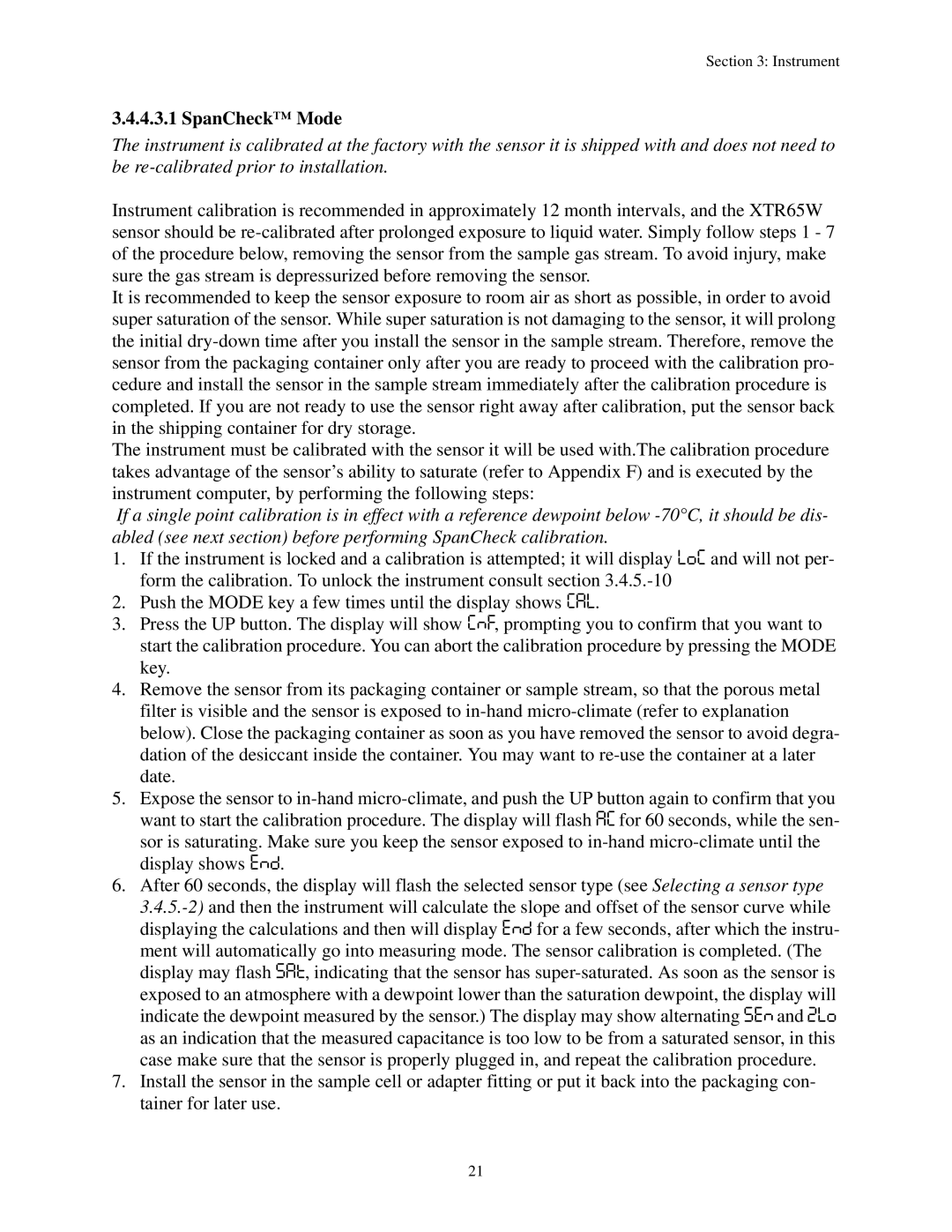Section 3: Instrument
3.4.4.3.1 SpanCheck™ Mode
The instrument is calibrated at the factory with the sensor it is shipped with and does not need to be re-calibrated prior to installation.
Instrument calibration is recommended in approximately 12 month intervals, and the XTR65W sensor should be re-calibrated after prolonged exposure to liquid water. Simply follow steps 1 - 7 of the procedure below, removing the sensor from the sample gas stream. To avoid injury, make sure the gas stream is depressurized before removing the sensor.
It is recommended to keep the sensor exposure to room air as short as possible, in order to avoid super saturation of the sensor. While super saturation is not damaging to the sensor, it will prolong the initial dry-down time after you install the sensor in the sample stream. Therefore, remove the sensor from the packaging container only after you are ready to proceed with the calibration pro- cedure and install the sensor in the sample stream immediately after the calibration procedure is completed. If you are not ready to use the sensor right away after calibration, put the sensor back in the shipping container for dry storage.
The instrument must be calibrated with the sensor it will be used with.The calibration procedure takes advantage of the sensor’s ability to saturate (refer to Appendix F) and is executed by the instrument computer, by performing the following steps:
If a single point calibration is in effect with a reference dewpoint below -70°C, it should be dis- abled (see next section) before performing SpanCheck calibration.
1.If the instrument is locked and a calibration is attempted; it will display LOC and will not per- form the calibration. To unlock the instrument consult section 3.4.5.-10
2.Push the MODE key a few times until the display shows CAL.
3.Press the UP button. The display will show CNF, prompting you to confirm that you want to start the calibration procedure. You can abort the calibration procedure by pressing the MODE key.
4.Remove the sensor from its packaging container or sample stream, so that the porous metal filter is visible and the sensor is exposed to in-hand micro-climate (refer to explanation below). Close the packaging container as soon as you have removed the sensor to avoid degra- dation of the desiccant inside the container. You may want to re-use the container at a later date.
5.Expose the sensor to in-handmicro-climate, and push the UP button again to confirm that you want to start the calibration procedure. The display will flash AC for 60 seconds, while the sen- sor is saturating. Make sure you keep the sensor exposed to in-handmicro-climate until the display shows END.
6.After 60 seconds, the display will flash the selected sensor type (see Selecting a sensor type 3.4.5.-2)and then the instrument will calculate the slope and offset of the sensor curve while displaying the calculations and then will display END for a few seconds, after which the instru- ment will automatically go into measuring mode. The sensor calibration is completed. (The display may flash SAT, indicating that the sensor has super-saturated. As soon as the sensor is exposed to an atmosphere with a dewpoint lower than the saturation dewpoint, the display will indicate the dewpoint measured by the sensor.) The display may show alternating SEN and 2LO as an indication that the measured capacitance is too low to be from a saturated sensor, in this case make sure that the sensor is properly plugged in, and repeat the calibration procedure.
7.Install the sensor in the sample cell or adapter fitting or put it back into the packaging con- tainer for later use.
